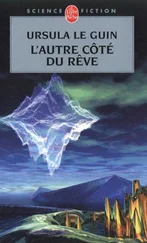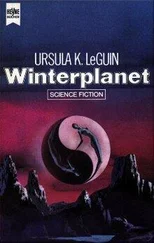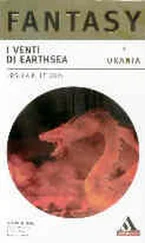“Staying,” Gana said.
“You crazy housefolk,” the woman said, turned away, turned back, gave it up with a shrug, and went on.
A few others stopped, but none for more than a question, a moment. They streamed on down the terraces, the sunlit paths beside the quiet pools, down towards the boathouses beyond the great tree. After a while they were all gone.
The sun had grown hot. It must be near noon. Metoy was whiter than ever, but he sat up, saying he could see single, most of the time.
“We should get into the shade, Gana,” Esdan said. “Metoy, can you get up?”
He staggered and shambled, but walked without help, and they got to the shade of a garden wall. Gana went off to look for water. Kamsa was carrying Rekam in her arms, close against her breast, sheltered from the sun. She had not spoken for a long time. When they had settled down she said, half questioning, looking around dully, “We are all alone here.”
“There’ll be others stayed. In the compounds,” Metoy said. “They’ll turn up.”
Gana came back; she had no vessel to carry water in, but had soaked her scarf, and laid the cold wet cloth on Metoy’s head. He shuddered. “You can walk better, then we can go to the house-compound, cutfree,” she said. “Places we can live in, there.”
“House-compound is where I grew up, grandmother,” he said.
And presently, when he said he could walk, they made their halt and lame way down a road which Esdan vaguely remembered, the road to the crouchcage. It seemed a long road. They came to the high compound wall and the gate standing open.
Esdan turned to look back at the ruins of the great house for a moment. Gana stopped beside him.
“Rekam died,” she said under her breath.
He caught his breath. “When?”
She shook her head. “I don’t know. She wants to hold him. She’s done with holding him, then she will let him go.” She looked in the open gateway at the rows of huts and longhouses, the dried-up garden patches, the dusty ground. “Lotsalot little babies are in there,” she said. “In that ground. Two of my own. Her sisters.” She went in, following Kamsa. Esdan stood a while longer in the gateway, and then he went in to do what there was for him to do: dig a grave for the child, and wait with the others for the Liberation.
1. PRONUNCIATION OF NAMES AND WORDS
In VOE DEAN (which is also the language of Yeowe) and GATAYAN, vowels have the usual “European values”:
a as in father (ah)
e as in hey (ay) or let (eh)
i as in machine (ee) or it (ih)
o as in go (o) or off (oh)
u as in ruby (oo)
In Voe Dean the accent is normally on the next-to-last syllable. Thus:
Arkamye—ar-KAHM-yeh
Bambur—BAHM-boor
Boeba—bo-AY-bah
Dosse—DOHS-she
Erod—EH-rod
gareot—gah-RAY-ot
Gatay—gah-TAH-ee
gede—GHEH-deh
Geu—GAY-oo
Hame—HAH-meh
Hagayot—hah-GAH-yot
Hayawa—hah-YAH-wah
Kamye—KAHM-yeh
Keo—KAY-o
makil—MAH-kihl
Nadami—nah-DAH-mee
Noeha—no-AY-hah
Ramayo—rah-MAH-yo
rega—RAY-gah
Rewe—REH-weh
San Ubattat—sahn-oo-BAHT-taht
Seugi—say-OO-ghee
Shomeke—sho-MEH-keh
Suhame—soo-HAH-meh
Tazeu—tah-ZAY-oo
Teyeo—teh-YAY-o
Tikuli—tee-KOO-lee
Toebawe—to-eh-BAH-weh
Tual—too-AHL or TWAHL
veot—VAY-ot
Voe Deo—vo-eh-DAY-o
Walsu—WAHL-soo
Werel—WEH-rehl
Yeowe—yay-O-way
Yeron—YEH-rohn
Yoke—YO-keh
Yotebber—yo-TEHB-ber
Yowa—YO-wah
Names formed with the name of the deities Kamye (Kam) and Tual tend to keep a stress on that element, thus:
Abberkam—AHB-ber-KAHM
Batikam—BAH-tih-KAHM
Rakam—RAH-KAHM
Sezi-Tual—SAY-zih-TWAHL
Tualtak—TWAHL-tahk
HAINISH
(The extremely long lineage-names common among the Hainish are cut down for daily use; thus Mattin-yehedarhed-dyura-ga-muruskets becomes Yehedarhed.)
araha—ah-RAH-ha
Ekumen ( from an Ancient Terran word )—EK-yoo-men
Esdardon Aya—ez-DAR-don-AH-ya
Havzhiva—HAHV-zhi-vah
Iyan Iyan—ee-YAHN-ee-YAHN
Kathhad—KAHTH-hahd
Mezhe—MEH-zheh
Stse—STSEH ( like the capitalized letters in English “beST SEt”)
Tiu—TYOO
Ve—VEH
Yehedarhed—yeh-heh-DAR-hed
2. THE PLANETS WEREL AND YEOWE
From A Handbook of the Known Worlds, printed in Darranda, Hain, Hainish Cycle 93, Local Year 5467 .
Ekumenical Year 2102 is counted as Present when historical dates are given as years Before Present (BP) .
The Werel-Yeowe solar system consists of 16 planets orbiting a yellow-white star (RK-tamo-5544-34). Life developed on the third, fourth, and fifth planets. The fifth, called Rakuli in Voe Dean, has only invertebrate life-forms tolerant of arid cold, and has not been exploited or colonised. The third and fourth planets, Yeowe and Werel, are well within the Hainish Norm of atmosphere, gravity, climate, etc. Werel was colonised by Hain late in the Expansion, within the last million years. It appears that there was no native fauna to displace, as all animal life-forms found on Werel, as well as some flora, are of Hainish derivation. Yeowe had no animal life until Werel colonised it 365 years BP.
WEREL
Natural History
The fourth planet out from its sun, Werel has seven small moons. Its current climate is cool temperate, severely cold at the poles. Its flora is largely indigenous, its fauna entirely of Hainish origin, modified deliberately to obtain cobiosis with the native plants, and further modified through genetic drift and adaptation. Human adaptations include a cyanotic skin coloration 572.25–26 cyanotic skin coloration] See note 338.10 . 576.31 Kwan Yin–like] Kwan Yin or Guanyin, an East Asian Buddhist divinity commonly called the “Goddess of Mercy.”
(from black to pale, with a bluish cast) and eyes without visible whites, both evidently adjustments to elements in the solar radiation spectrum.
Voe Deo: Recent History : 4000–3500 years BP, aggressive, progressive black-skinned people from south of the equator on the single great continent (the region that is now the nation of Voe Deo) invaded and dominated the lighter-skinned peoples of the north. These conquerors instituted a master-slave society based on skin color.
Voe Deo is the largest, most numerous, wealthiest nation on the planet; all other nations in both hemispheres are dependencies, client states, or economically dependent on Voe Deo. Voe Dean economics have been based on capitalism and slavery for at least 3000 years. Voe Dean hegemony permits the general description of Werel as if it were all one society. As the society is in rapid change, however, this account will be put in the past tense.
Social Classes under Slavery:
Class:master ( owneror gareot) and slave ( asset). Your class was your mother’s class, without exception.
Skin colorranges from blue-black through bluish or greyish beige to an almost depigmented white. (Only albinism affects hair and eyes, which are dark.) Ideally and in the abstract, class was skin color: owners black, assets white. Actually, many owners were black, most were dark; some assets were black, most beige, some white.
OWNERSwere called men, women, children.
The unqualified word owner meant either the class as a whole or an individual/family owning two or more slaves.
Читать дальше








